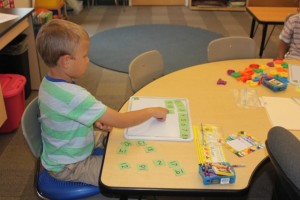by Patty Keith, M.Ed. Lower and Intermediate Schools Division Head, The Fletcher School
As the Division Head of the Lower and Intermediate Schools at The Fletcher School and someone who has spent my career working with students with specific learning disabilities I am often asked the questions, “What are the early signs of a learning disability?” and “How do I know if my child has a learning disability?”
Before I begin to offer some answers to those questions, it is important to understand what exactly a learning disability is. In simple terms, a learning disability results from a difference in the way a child’s brain is “wired.” Students with learning disabilities do not look different than other children. They have average or above average intelligence. Learning Disabilities are neurologically based and interfere with the ability to master specific learning skills. Children with learning disabilities are as smart or smarter than their peers but they may have difficulty reading, writing, spelling, reasoning, recalling, and/or organizing information if left to figure things out on their own or taught in conventional ways. A learning disability can’t be cured or fixed; it is a lifelong issue. However, with the right support and intervention, children with learning disabilities can succeed in school and in life. In fact, specific learning disabilities are very common! Those with learning disabilities are often times considered “out of the box” thinkers–Walt Disney, Winston Churchill, Anderson Cooper, Charles Schwab, Ted Turner, and Steven Spielberg just to name a few.
A Few Facts About Learning Disabilities from www.ldonline.org:
– Fifteen percent of the U.S. population, or one in seven Americans, has some type of learning disability, according to the National Institutes of Health.
– Difficulty with basic reading and language skills are the most common learning disabilities. As many as 80% of students with learning disabilities have reading problems.
– Learning disabilities often run in families.
– Learning disabilities should not be confused with other disabilities such as autism, intellectual disability, deafness, blindness, and behavioral disorders. None of these conditions are learning disabilities. In addition, they should not be confused with lack of educational opportunities like frequent changes of schools or attendance problems. Also, children who are learning English do not necessarily have a learning disability.
– Attention disorders, such as Attention Deficit/Hyperactivity Disorder (ADHD) and learning disabilities often occur at the same time, but the two disorders are not the same.
Research shows us that early intervention of learning disabilities enables young learners to gain basic skills that help build a strong foundation for future academic success. Here are a few key precursors or “red flags” of an emerging learning disability in a pre-school and/or early elementary age learner:
1. Pre-Academic Skills:
– doesn’t hear rhyming words nor generate words that rhyme
– phonemic awareness: doesn’t recognize sounds, sequence sounds, blend sounds, manipulate individual sounds within words (m-o-p = mop; change m to t = top)
– doesn’t recall letter sounds
– doesn’t recognize or recall alphabet letters
– doesn’t recognize letters in their name
– doesn’t recognize numbers 1-9; difficulty with 1 to 1 correspondence
– doesn’t know basic colors and shapes
– difficulty with directionality terms: front/back, first/last, left/right, over/under, up/down – indicators that child may have difficulty with reading
– difficulty applying skills taught
– does not pretend to read
2. Language:
– expressive: doesn’t speak in complete sentences — typically a child uses 8 words per sentence; can’t organize thoughts to express ideas; poor word recall and retrieval — makes lots of extraneous comments when trying to answer a question or tell a story; difficulty communicating with adults and peers
– receptive: doesn’t follow oral directions due to not understanding what he is told; doesn’t follow multi-step directions; doesn’t comprehend stories read to him; difficulty with answering a two part question
3. Fine/gross motor skills:
– incorrect/immature pencil grip
– difficulty holding/cutting with scissors
– difficulty cutting along a straight line
– difficulty with snapping or buttoning clothes
– difficulty stringing beads
– difficulty skipping, ball throwing/catching
– difficulty picking up popcorn kernel or an M&M — will likely have a hard time with pencil grip
4. Visual motor skills:
– difficulty tracking symbols, letters, numbers left-to-right
– difficulty copying from board to paper or paper to paper
– writes letters/numbers in reverse formation
– difficulty with visual perception
5. Working memory:
– difficulty with short term auditory or visual attention
– difficulty following directions
– difficulty holding information in attention while manipulating it
– difficulty with sequencing
– difficulty with rote memory of daily info. (days of week, months, counting)
– difficulty retaining taught skills — requires lots of review and repetition to recall and apply
6. Executive functioning:
– weaknesses with organization of materials
– difficulty with self-regulation of emotions and behavior
– trouble understanding new tasks
– difficulty making predictions
– difficulty with transitioning from one activity to another
– needs to be prepared in advance for new or novel situations
7. Processing speed:
– difficulty with visual concepts and categorization
– difficulty quickly scanning symbols and making decisions about them
– weaknesses with visual discrimination
– difficulty with eye-hand coordination
– weaknesses with pencil control
It’s important to note, that difficulty in just one of these areas does not indicate an emerging learning disability. However, if you notice a pattern in skills deficiency it may be time to seek a psychoeducational evaluation for your child. Moving forward with a psychoeducational evaluation is critical to understanding exactly how your child learns. Think of the evaluation as your child’s brain on paper. In a nutshell, here are the pieces that make up a typical psychoeducational report:
– Developmental History and Background Information
– Testing Observations
– Cognitive Functioning
– Oral Language Skills
– Comprehension
– Verbal Expression
– Visual Processing and Visual-Spatial-Motor Integration
– Academic Achievement Testing
– Behavioral and Emotional Functioning
– Summary of Findings
Once your child’s testing is complete, the psychologist will review each portion of the evaluation with you and will note any causes for concern.
In general, parents should “trust their guts” when observing their children and considering a psychoeducational evaluation. You spend spend time with your child each and every day and are most likely to notice if/when they are not progressing as they should. You can help your child achieve success by encouraging their strengths, knowing their weaknesses, understanding the educational system, working with professionals and learning about strategies for dealing with specific difficulties.
#####
If this topic is of particular interest to you, mark your calendar for Tuesday, September 20th at 7:00 PM to join us at The Fletcher School for Early Identification of Developing Learning Issues in Preschool presented by Terri James, Ph.D. of Southeast Psychological Services. This program is sponsored through The Rankin Institute at The Fletcher School. Established in 2004 as an outreach of the School, programs are designed to provide education and resources to teachers, professionals, and parents beyond those directly involved with the academic programs at Fletcher. To find out more about The Fletcher School, The Rankin Insititute, or to register for this program visit http://www.thefletcherschool.org/rankin-institute/.
![]()
The Fletcher School
8500 Sardis Road
Charlotte, NC 28270
704-365-4658
www.thefletcherschool.org
Facebook
Twitter @fletcherfalcons



1 comment
Wonderful school